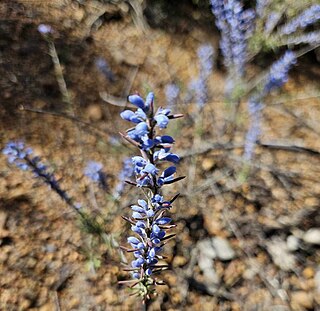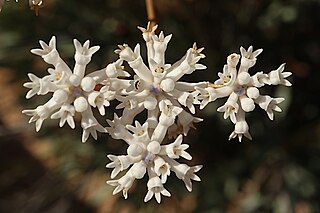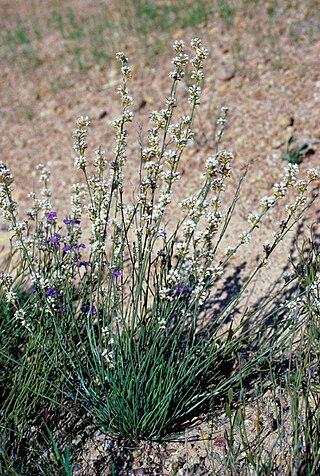
Conospermum glumaceum, commonly known as hooded smokebush, is a species of flowering plant in the family Proteaceae and is endemic to the south-west of Western Australia. It is an erect shrub with more or less clustered, linear leaves, and panicles of dense, head-like spikes of tube-shaped, cream-coloured flowers and white to golden nuts.

Conospermum mitchellii, commonly known as Victorian smokebush, is a species of flowering plant of the family Proteaceae and is endemic to the western half of Victoria. It is an erect shrub with crowded, linear leaves, panicles of white, blue or lilac flowers and orange or reddish brown nuts.

Conospermum amoenum, commonly known as blue smokebush, is a species of flowering plant in the family Proteaceae and is endemic to the south-west of Western Australia. It is an erect or spreading shrub with linear leaves, and spikes of blue or white tube-shaped flowers.

Conospermum boreale is a species of flowering plant in the family Proteaceae and is endemic to the south-west of Western Australia. It is an erect, much-branched shrub with egg-shaped to elliptic or lance-shaped leaves, and panicles of woolly, white flowers.

Conospermum bracteosum is a species of flowering plant in the family Proteaceae and is endemic to the south-west of Western Australia. It is an erect, spindly shrub with egg-shaped leaves, sometimes with the narrower end towards the base, and spikes of silky, woolly, tube-shaped white flowers.

Conospermum brownii, commonly known as blue-eyed smokebush, is a species of flowering plant in the family Proteaceae and is endemic to the south-west of Western Australia. It is a more or less open shrub with glaucous, lance-shaped leaves with the narrower end towards the base, and spike-like corymbs of white to cream-coloured flowers.

Conospermum canaliculatum is a species of flowering plant in the family Proteaceae, and is endemic to the south-west of Western Australia. It is a dense, multistemmed, erect shrub with linear leaves and spike-like panicles of woolly white, tube-shaped flowers.

Conospermum crassinervium, commonly known as summer smokebush or tassel smokebush, is a species of flowering plant in the family Proteaceae, and is endemic to the south-west of Western Australia. It is a low, tufted shrub with clustered leaves arranged at the base of the plant and corymbs of spikes of white to grey, hairy, tube-shaped flowers.

Conospermum croniniae is a species of flowering plant in the family Proteaceae and is endemic to the south-west of Western Australia. It is an erect, open shrub with spreading cylindrical leaves and spikes of up to 6 pale blue or pink, tube-shaped, hairy flowers.

Conospermum densiflorum, commonly known as crown smokebush, is a species of flowering plant in the family Proteaceae and is endemic to the south-west of Western Australia. It is an erect, much-branched shrub with thread-like leaves at the base of the plant, and spikes or corymbs of velvety, cream-coloured or blue, tube-shaped flowers.

Conospermum ephedroides is a species of flowering plant in the family Proteaceae and is endemic to the south-west of Western Australia. It is a tufted shrub with many stems, a few cylindrical leaves at the base of the plant, and sessile spikes of glabrous white, pale pink or blue, tube-shaped flowers and reddish-brown to orange nuts.

Conospermum filifolium is a species of flowering plant in the family Proteaceae and is endemic to the south-west of Western Australia. It is a shrub with thread-like, S-shaped leaves, and spike-like panicles of woolly white, occasionally blue, tube-shaped flowers.

Conospermum floribundum is a species of flowering plant in the family Proteaceae and is endemic to the south of Western Australia. It is a compact, erect shrub with narrowly linear leaves that are circular in cross-section, and spike-like panicles of white, tube-shaped flowers with blue tips.
Conospermum galeatum is a species of flowering plant in the family Proteaceae and is endemic to the south-west of Western Australia. It is an open shrub with threadlike, channelled leaves, and panicles of spikes of woolly white flowers with blue bracteoles.

Conospermum huegelii, commonly known as the slender smokebush, is a species of flowering plant endemic to the south-west of Western Australia. It is a low, clumped shrub with thread-like to narrowly cylindrical leaves, and spikes of pale blue to cream-coloured, tube-shaped flowers and hairy nuts.

Conospermum leianthum is a species of flowering plant in the family Proteaceae and is endemic to the south-west of Western Australia. It is a shrub with thread-like leaves, and panicles of white and more or less purple, tube-shaped flowers.
Conospermum microflorum is a species of flowering plant of the family Proteaceae and is endemic to Western Australia. It is a rounded shrub with glabrous, thread-like leaves, panicles of woolly hairy, white or cream coloured flowers and woolly hairy, orange-brown nuts.
Conospermum multispicatum is a species of flowering plant of the family Proteaceae and is endemic to the south-west of Western Australia. It is a dense, rounded shrub with glabrous leaves that are round in cross section, spikes of woolly hairy, white flowers and woolly hairy nuts.

Petrophile plumosa is a species of flowering plant in the family Proteaceae and is endemic to southwestern Western Australia. It is a shrub with rigid, sharply-pointed, sometimes lobed leaves, and more or less spherical heads of hairy, pale yellow flowers.

Conospermum hookeri, commonly known as Tasmanian smokebush, is a species of flowering plant in the family Proteaceae and is endemic to Tasmania. It is a shrub with many branches, spatula-shaped or linear leaves, panicles of spikes of white, tube-shaped flowers and reddish brown nuts covered with silky fawn-coloured hairs.


















